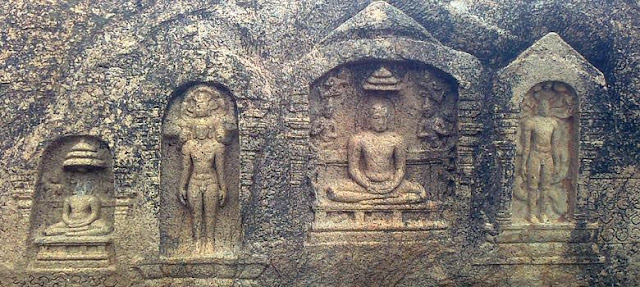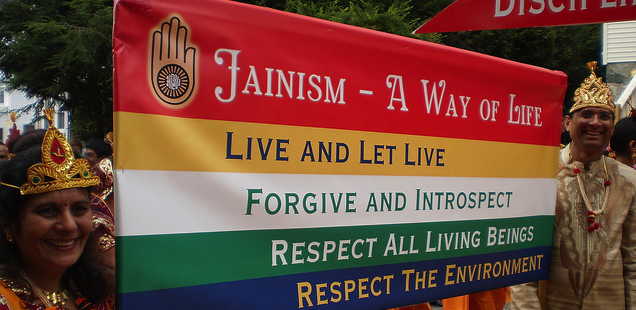JAINISM
One
should treat all creatures in the world as one would like to be treated
-Mahavira
Jainism, Indian religion teaching a path to
spiritual purity and enlightenment through disciplined nonviolence (ahimsa, literally “non injury”)
to all living creatures.
The aim of Jain life is to achieve liberation of the soul.
Origin of Jainism:
 Jainism is one of the oldest religions of India.
We do not know exactly when it was founded. The Jains themselves say that
Jainism has existed since eternity and it had like the Jain universe no beginning and would have
no end. Most of the saints of Jainism belonged to remote ages, millions and
billions of years ago. However, for practical purposes we may take Mahavira,
their last great saint, as a historical figure. He was a contemporary of the
Buddha.
Jainism is one of the oldest religions of India.
We do not know exactly when it was founded. The Jains themselves say that
Jainism has existed since eternity and it had like the Jain universe no beginning and would have
no end. Most of the saints of Jainism belonged to remote ages, millions and
billions of years ago. However, for practical purposes we may take Mahavira,
their last great saint, as a historical figure. He was a contemporary of the
Buddha.What is Jainism?
Jainism - The 'Jains' are the followers of the Jinas.
Literally Jina means a conqueror, that is, one who has
conquered the worldly passions like desire, hatred, anger, greed, pride, etc.
by one's own strenuous efforts and has been liberated himself from the bonds of
worldly existence, the cycle of births and deaths. Jina, therefore, is a human
being and not a supernatural being or an incarnation of an all mighty God.
Hence the term Jina is applied to a person who is a spiritual victor.
Further, human beings
have the potentiality to become Jinas and, as such, Jinas are persons of this
world who have attained supreme knowledge, subjugated their passion and are
free from all sorts of attachment and aversion. Jainism is thus a set of
principles preached by the Jinas. Hence Jainism is not an apauruseya religion,
i.e., a religion propounded by a non-human being or based on a sacred book of
non-human origin. On the contrary it is a religion of purely human origin and
is preached by one who has attained omniscience and self-control by his own
personal efforts. In short, Jainism is the substance of the preaching of those
perfect souls who have attained the state of Jinas.
History of Jainism:
Jainism is an
independent and most ancient religion of India. Jainsim is an eternal
religion. Jainism is revealed in every cyclic period of the universe, and
this constitutes the pre-historic time of Jainism. And there is a recorded
history of Jainism since about 3000-3500 BC.
The discovery of the
Indus Civilization seems to have thrown a new light on the antiquity of
Jainism. The evidence suggests that Jainism was known among the people of the
Indus Valley around 3000-3500 B.C. Some nude figures, considered to be of Rishabha Dev. on the seals have been discovered at Mohenjo-Daro
and Harappa. There is an article that suggests the representation of the
seventh Tirthankara Suparshvanath. The people of the Indus Valley not only
practiced Yoga but worshipped the images of Yogis. There are figures in
Kayotsarga posture of standing are peculiarly Jain.
In addition, the
sacred signs of swastika are found engraved on a number of
seals. Furthermore, there are some motifs on the seals found in Mohenjo-Daro
and it is suggested that these motifs are identical with those found in the
ancient Jain art of Mathura. This presence of Jain tradition in the
earliest period of Indian history is supported by many scholars. It strongly
suggests that Jainism existed in pre-Aryan time
Tirthankaras
A tirthankara appears in the world to teach the way to
moksha, or liberation.
A Tirthankar is not an incarnation of the God. He is an ordinary soul that is born as a human and attains the states of a
Tirthankar as a result of intense practices of penance, equanimity and
meditation. As such, the Tirthankar is not defined as an Avatar (god-incarnate)
but is the ultimate pure developed state of the soul.
Tirthankaras were not founders of any religion, but great
omniscient teachers who lived at various times in man's cultural history. They
accomplished the highest spiritual goal of existence and then taught their
contemporaries the way to reach it by crossing over to the safe shores of
spiritual purity.
The 24 tirthankaras during this present age are:
Adinatha, Ajita, Sambhava, Abhinandana, Sumati,
Padmaprabha, Suparshva, Chandraprabha, Suvidhi, Shital, Shreyansa, Vasupujya,
Vimala, Ananta, Dharma, Shanti, Kunthu, Ara, Malli, Muni Suvrata, Nami, Nemi,
Parshva and Mahavira.
Jain sects
The Jains are divided into two major sects,
Digambar and Svetambar. The differences between the two sects are minor and
relatively obscure. Digambar Jain monks do not wear clothes while Svetambar
Jain monks, wear white, seamless clothes.
These groups were formed nearly after six hundred years after the Nirvan of Tirthankar Lord
Mahavira.
Do jains believe in reincarnation?
Yes, they believe in reincarnation. Their souls, which are believed to be a
unique substance in the universe, take different living forms in the cycle of
birth, death, and rebirth. This
cycle has been going on forever, the universe has no beginning or end, it has
always been and always will be.
The five vows of jains
The jain code of conduct is made up of
the following five vows, and all of their logical conclusions:
1. Ahimsa (nonviolence)
2. Satya (truthfulness)
3. Asteya (non-stealing)
4. Aparigraha (non-possessiveness)
5. Brahmcharya (chastity)
Jain
religion focuses much attention on Aparigraha, non-possessiveness towards
material things through self-control, self-imposed penance, abstinence from
over-indulgence, voluntary curtailment of one's needs, and the consequent
subsiding of the aggressive urge.
-Swetha












0 Comments